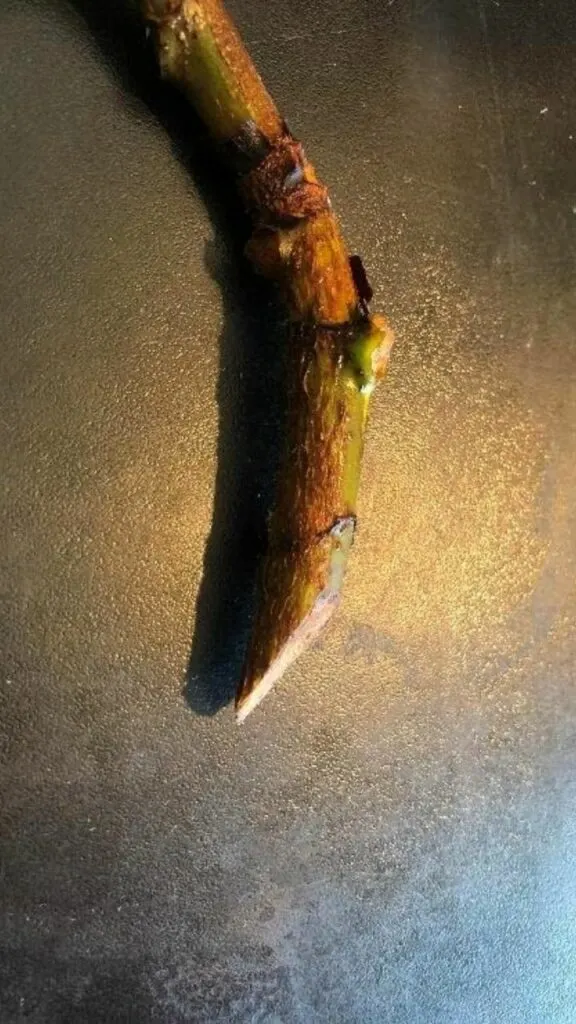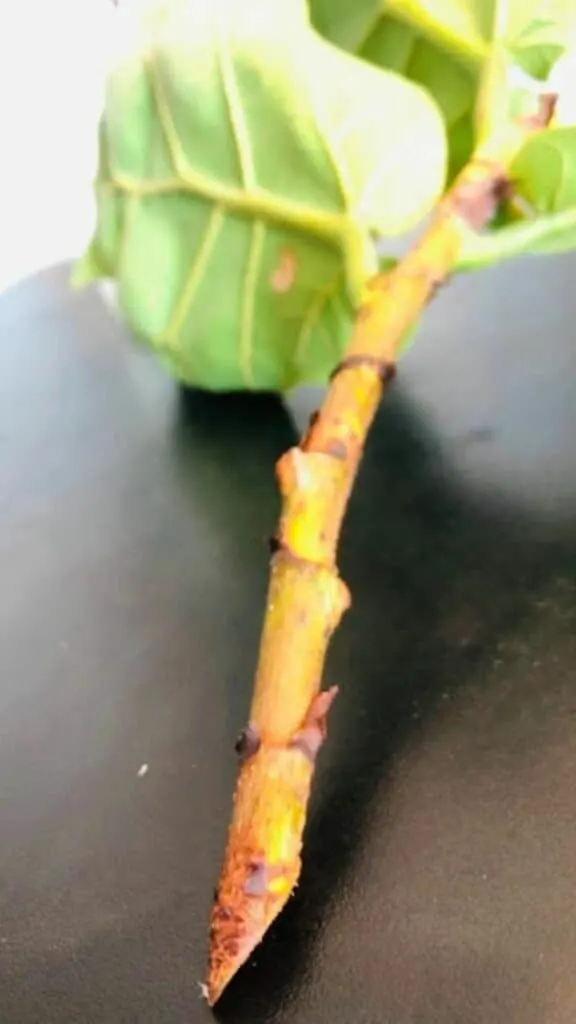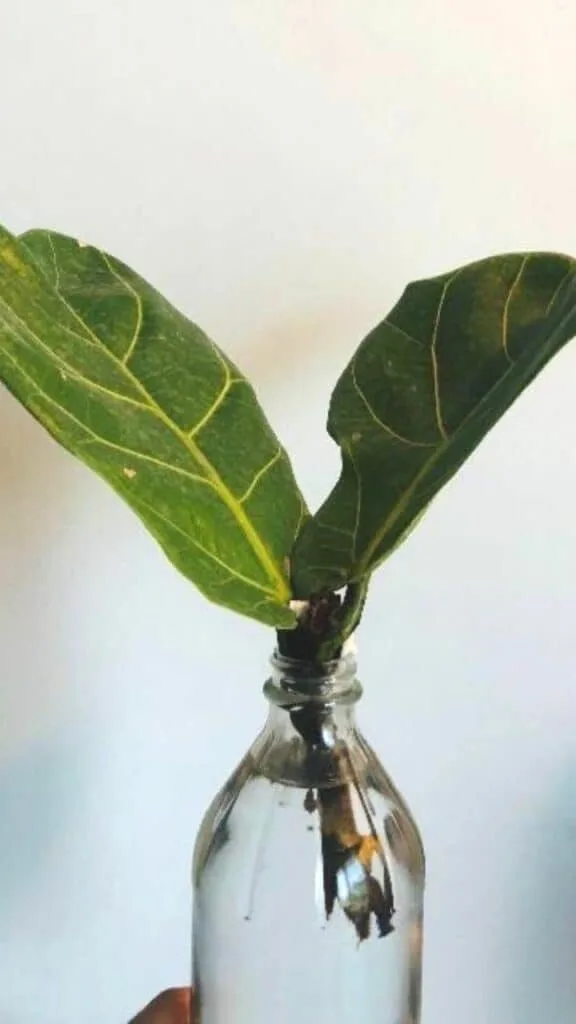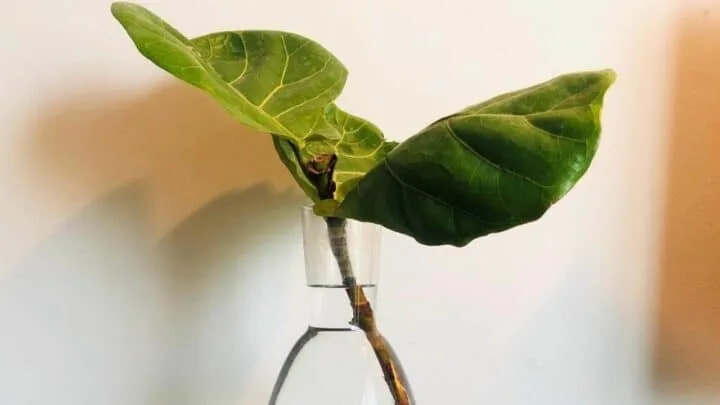Make way for its majesty, the king of houseplants, the one, and only Fiddle Leaf Fig.
With its glossy green and bold foliage, the Ficus Lyrata, aka FLF, has taken the realm of houseplants by storm.
With its large and fiddle-shaped leaves, this member of the Ficus family has been the go-to indoor plant for Instagrammers and interior designers for as long as we can remember.
Given the right conditions, this rainforest plant can be a rampant grower, and you may soon find it taking over your living space. Pruning such magnificent foliage back to size is a pain, but not so much if we can make new plants out of it!
Table of Contents
How to Propagate Fiddle Leaf Fig in Water?
Take cuttings from a healthy Fiddle Leaf Fig using a sharp and clean pruner. Each stem should be at least 6 inches long. Cut off all leaves, leaving two at the top. After washing, place the cuttings in clean water and bright, indirect light. Roots will grow within 3-4 weeks, then transplant to a pot.
What is the Right Season to Propagate Fiddle Leaf Fig?
The first and foremost factor to consider when propagating an FLF is the time of the year.
This is because many novice plant parents go about trying hard to propagate plants at the wrong time of the year, all in vain.
Spring is the ideal time to take Fiddle Leaf Fig cuttings and propagating them. This is when the tropical plant starts to come out of its dormancy and starts growing new roots.
You want to be careful not to take cuttings too early in the spring as temperatures are too low for plant growth. The ideal temperature range for FLF propagation is 65-75°F (18-24°C).
Summer is also viable for propagation as long as you can provide the fragile cuttings with a safe and mild environment.
You want to give the young plants as much time as possible to establish themselves before winter comes.
How to Take Fiddle Leaf Fig Stem Cuttings?
Taking cuttings the right way is the first step towards successful Fiddle Leaf Fig propagation.
Before you cut anything, it is a good idea to select which branches to cut and the location of the cut.
You should look for branches that have no more than two or three leaves. If there are more leaves, you can simply snap them off.
Cut each stem so that each cutting is at least 6 inches long.
Use a sharp and sterilized pair of garden shears to not infect any part of the plant. It is best if you make a slanting cut on each stem so that the cutting can absorb maximum water.

Nodes are specific locations on a stem from where a leaf or a bud grows. These are the exact locations from where roots grow in propagation.
When you take a cutting, ensure that one or two nodes at the bottom end will go under the propagation medium.

Preparing Propagation Medium
When rooting Fiddle Leaf Fig Cuttings, you need to take care of a few things before placing the cuttings in the water.
You need to have a clear and clean container for the water which can keep the cuttings upright.
A tall glass vase or with a narrow neck or a simple bottle is perfect. A huge benefit of using transparent containers is that you can monitor the root growth in real-time.

One of the most important things you need to consider when propagating FLF in water is the quality of water you’re using. Using clean drinking water is recommended.
But if you’re using tap water, ensure that you let it stay overnight so all the chlorine in the water can evaporate.
Caring for Fiddle Leaf Fig Cuttings
After placing your cuttings in the water container, you need to give them a bright and warm corner.
Bright, indirect daylight is essential for FLF propagation, and the cuttings will root faster when given the right light.
Make sure the cuttings don’t receive any direct sunlight as it can burn the leaves and make the cutting die. You may need to replace the water a few times if it looks like it needs to be changed.
New, pop-corn-like white spots may start appearing around the nodes at the end of four weeks. The cuttings will have a developed root system by 6-8 weeks.
Transplanting to Soil
When the roots on each cutting are at least 1-2 inches long, you can take them out of the water and put them in a pot. However, you must be very careful at this critical stage of FLF propagation.
Use a well-draining potting mix for houseplants to pot your Fiddle Leaf Fig cuttings. Ensure that the roots are well settled in the soil, and there are no air pockets when you plant them.
After potting, water the cuttings lightly so that the soil can shrink closer to the roots and keeps them damp.
For the next two months, keep special care of the baby Fiddle Leaf Figs and ensure that the soil is consistently moist at all times.
Underwatering and overwatering can prove fatal for the young and delicate Fiddles, so you must not take any chances.
Let the plants grow for about three months before you fertilize them.
The baby FLFs will not start growing vigorously, at least not until they’re a year old. Keep them somewhere they receive adequate, indirect sunlight.
Morning or afternoon sun is also good, but make sure it doesn’t get too harsh on them.
Frequently asked questions about Fiddle Leaf Fig Propagation
Can I propagate Fiddle Leaf Fig from a leaf?
Contrary to popular belief, Ficus Lyrata cannot be successfully propagated from leaves. You can only get roots growing out of the petiole of the leaf, but there will be no more growth other than that.
How long can I keep Fiddle Leaf Fig cuttings in the water?
Fiddle Leaf Fig cuttings should ideally be transplanted as soon as the roots are one inch long. The plant needs nutrients other than just water to grow new foliage. Cuttings should not be kept for more than a few weeks in water after the roots have grown.

Daniel has been a plant enthusiast for over 20 years. He owns hundreds of houseplants and prepares for the chili growing seasons yearly with great anticipation. His favorite plants are plant species in the Araceae family, such as Monstera, Philodendron, and Anthurium. He also loves gardening and is growing hot peppers, tomatoes, and many more vegetables.


